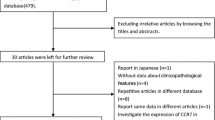Abstract
Purpose
Gastric cancer is the second leading cause of cancer-related deaths worldwide and the most common gastrointestinal cancer in Iran. Chemokine ligand 5 (CCL5/RANTES) is one of the most potent angiogenic factors that plays an important role in tumor growth, invasion, and metastasis. We aimed to assess the serum level of CCL5 in patients with gastric adenocarcinoma and its relation with histological grade and tumor stage, as well as the disease prognosis.
Methods
Seventy-four patients with gastric adenocarcinoma that had undergone gastrectomy and 96 non-tumoral cases in which gastric cancer was ruled out by gastroscopy and biopsy were enrolled. Demographic and epidemiological characteristics and patient survival data were reviewed. Histological type, grade, and tumor stage (TNM) were determined by a single expert pathologist. Helicobacter pylori infection status and CCL5 serum level were measured by ELISA. Data were analyzed using SPSS software version 16.
Results
Patients with gastric adenocarcinoma had significantly higher serum CCL5 level compared with control group (P < .001). Higher serum CCL5 levels were associated with lower histological differentiation (P < .001), higher depth of tumor invasion (P = .022), more frequent lymph nodes involvement (P = .028), and advanced tumor stage (P = .002). The overall survival of patients with CCL5 levels higher than 70,671 pg/ml was significantly lower than those with lower than this cutoff (P = .043).
Conclusions
Serum CCL5 levels might be utilized as a predictive marker of tumor behavior and disease prognosis in patients with gastric adenocarcinoma. Further studies to assess tissue expression of CCL5 and its gene polymorphisms are suggested.


Similar content being viewed by others
References
Brenner H, Rothenbacher D, Arndt V. Epidemiology of stomach cancer. Methods Mol Biol. 2009;472:467–77.
Malekzadeh R, Derakhshan M, Malekzadeh Z. Gastric cancer in Iran: epidemiology and risk factors. Arch Iran Med. 2009;12(6):576–83.
Schall TJ, Bacon KB. Chemokines, leukocyte trafficking, and inflammation. Curr Opin Immunol. 1994;6(6):865–73.
Balkwill F. Chemokine biology in cancer. Semin Immunol. 2007;15(1):49–55.
Müller A, Homey B, Soto H, Ge N, Catron D, Buchanan ME, et al. Involvement of chemokine receptors in breast cancer metastasis. Nat. 2001;410(6824):50–6.
Murphy P. Chemokines and the molecular basis of cancer metastasis. N Engl J Med. 2001;345(11):833–5.
Singh S, Sadanandam A, Singh R. Chemokines in tumor angiogenesis and metastasis. Cancer Metastasis Rev. 2007;26(3–4):453–67.
Luboshits G, Shina S, Kaplan O, Engelberg S, Nass D, Lifshitz-Mercer B, et al. Elevated expression of the CC chemokine regulated on activation, normal T cell expressed and secreted (RANTES) in advanced breast carcinoma. Cancer Res. 1999;59(18):4681–7.
Azenshtein E, Luboshits G, Shina S, Neumark E, Shahbazian D, Weil M, et al. The CC chemokine RANTES in breast carcinoma progression: regulation of expression and potential mechanisms of promalignant activity. Cancer Res. 2002;62(4):1093–102.
Robinson SC, Scott KA, Wilson JL, Thompson RG, Proudfoot AE, Balkwill FR. A chemokine receptor antagonist inhibits experimental breast tumor growth. Cancer Res. 2003;63(23):8360–5.
Eissa SA, Zaki SA, El-Maghraby SM, Kadry DY. Importance of serum IL-18 and RANTES as markers for breast carcinoma progression. J Egypt Nat Cancer Inst. 2005;17(1):51–5.
Yaal-Hahoshen N, Shina S, Leider-Trejo L, Barnea I, Shabtai EL, Azenshtein E, et al. The chemokine CCL5 as a potential prognostic factor predicting disease progression in stage II breast cancer patients. Clin Cancer Res. 2006;12(15):4474–8.
Niwa Y, Akamatsu H, Niwa H. Correlation of tissue and plasma RANTES levels with disease course in patients with breast or cervical cancer. Clin Cancer Res. 2001;7(2):285–9.
Tsukishiro S, Suzumori N, Nishikawa H. Elevated serum RANTES levels in patients with ovarian cancer correlate with the extent of the disorder. Gynecol Oncol. 2006;102(3):542–5.
Vaday GG, Peehl DM, Kadam PA, Lawrence DM. Expression of CCL5 (RANTES) and CCR5 in prostate cancer. Prostate. 2006;66(2):124–34.
Kim HK, Song KS, Park YS, Kang YH, Lee YJ, Lee KR, et al. Elevated levels of circulating platelet micro particles. VEGF, IL-6 and RANTES in patients with gastric cancer: possible role of a metastasis predictor. Eur J Cancer. 2003;39(2):184–91.
Okita K, Furuhata T, Kimura Y, Kawakami M, Yamaguchi K, Tsuruma T, et al. The interplay between gastric cancer cell lines and PBMCs mediated by the CC chemokine RANTES plays an important role in tumor progression. J Exp Clin Cancer Res. 2005;24(3):439–46.
Sugasawa H, Ichikura T, Tsujimoto H, Kinoshita M, Morita D, Ono S, et al. Prognostic significance of expression of CCL5/RANTES receptors in patients with gastric cancer. J Surg Oncol. 2008;97(5):445–5.
Sugasawa H, Ichikura T, Kinoshita M, Ono S, Majima T, Tsujimoto H, et al. Gastric cancer cells exploit CD4+ cell-derived CCL5 for their growth and prevention of CD8+ cell-involved tumor elimination. Int J Cancer. 2008;122(11):2535–41.
Stolte M, Meining A. The updated Sydney system: classification and grading of gastritis as the basis of diagnosis and treatment. Can J Gastroenterol. 2001;15:591.
Green FL, Page DL, Fleming ID, Fritz A, Balch CM, Haller DG, et al. AJCC cancer staging manual. 6th ed. New York: Springer; 2002.
Sadjadi A, Malekzadeh R, Derakhshan MH, Sepehr A, Nouraie M, Sotoudeh M, et al. Cancer occurrence in Ardabil: results of a population-based cancer registry from Iran. Int J Cancer. 2003;107(1):113–8.
Acknowledgments
This paper has been written according to the result of the residency thesis of the first author. This study was supported by a grant (No. 88042) from Mashhad University of Medical Sciences. We would like to thank Dr. Abbas Esmaeilzadeh as well as our colleagues in Gastric Cancer Research Group and in the Endoscopy Unit of Imam Reza Hospital for their great cooperation.
Conflict of Interest
The authors declare that they have no conflict of interest.
Author information
Authors and Affiliations
Corresponding author
Rights and permissions
About this article
Cite this article
Sima, A.R., Sima, H.R., Rafatpanah, H. et al. Serum Chemokine Ligand 5 (CCL5/RANTES) Level Might be Utilized as a Predictive Marker of Tumor Behavior and Disease Prognosis in Patients with Gastric Adenocarcinoma. J Gastrointest Canc 45, 476–480 (2014). https://doi.org/10.1007/s12029-014-9652-5
Published:
Issue Date:
DOI: https://doi.org/10.1007/s12029-014-9652-5




